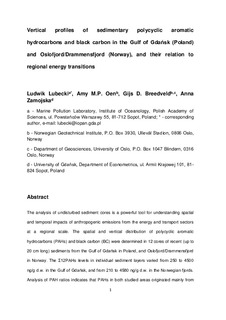| dc.contributor.author | Lubecki, Ludwik | |
| dc.contributor.author | Oen, Amy M P | |
| dc.contributor.author | Breedveld, Gijs D. | |
| dc.contributor.author | Zamojska, Anna | |
| dc.date.accessioned | 2018-09-11T09:37:18Z | |
| dc.date.available | 2018-09-11T09:37:18Z | |
| dc.date.created | 2018-08-07T14:07:14Z | |
| dc.date.issued | 2018 | |
| dc.identifier.citation | Science of the Total Environment. 2018, 646 336-346. | |
| dc.identifier.issn | 0048-9697 | |
| dc.identifier.uri | http://hdl.handle.net/11250/2561954 | |
| dc.description.abstract | The analysis of undisturbed sediment cores is a powerful tool for understanding spatial and temporal impacts of anthropogenic emissions from the energy and transport sectors at a regional scale. The spatial and vertical distribution of polycyclic aromatic hydrocarbons (PAHs) and black carbon (BC) were determined in 12 cores of recent (up to 20 cm long) sediments from the Gulf of Gdańsk in Poland, and Oslofjord/Drammensfjord in Norway. The Σ12PAHs levels in individual sediment layers varied from 250 to 4500 ng/g d.w. in the Gulf of Gdańsk, and from 210 to 4580 ng/g d.w. in the Norwegian fjords. Analysis of PAH ratios indicates that PAHs in both studied areas originated mainly from pyrogenic sources. The BC concentrations in sediments were up to 0.9% and were generally higher in the Gulf of Gdańsk (mean - 0.39%) than in Oslofjord/Drammensfjord (mean - 0.19%). The deposition history of anthropogenic emissions over the last 100 years was reconstructed based on the analysis of dated and well-laminated sediment cores from two stations from the Gulf of Gdańsk and two stations from the Norwegian fjords. The evolution in energy structure was especially evident in the Oslofjord, where transition from fossil fuel combustion to hydropower after 1960 coincided with a sharp decrease in sedimentary PAHs. Despite significant changes in the economic development in Poland, temporal patterns in PAH concentrations/profiles in the Gulf of Gdańsk were not as obvious. The historical PAH trends in the Gulf of Gdańsk may be related to the overwhelming PAH inputs from domestic combustion of solid fuels (coal, wood) for heating purposes. The implementation of legislation and other activities addressed to restrict the use of solid fuels in residential heating should reduce PAH emissions. | |
| dc.description.abstract | Vertical profiles of sedimentary polycyclic aromatic hydrocarbons and black carbon in the Gulf of Gdańsk (Poland) and Oslofjord/Drammensfjord (Norway), and their relation to regional energy transitions | |
| dc.language.iso | eng | |
| dc.title | Vertical profiles of sedimentary polycyclic aromatic hydrocarbons and black carbon in the Gulf of Gdańsk (Poland) and Oslofjord/Drammensfjord (Norway), and their relation to regional energy transitions | |
| dc.title.alternative | Vertical profiles of sedimentary polycyclic aromatic hydrocarbons and black carbon in the Gulf of Gdańsk (Poland) and Oslofjord/Drammensfjord (Norway), and their relation to regional energy transitions | |
| dc.type | Peer reviewed | |
| dc.type | Journal article | |
| dc.description.version | acceptedVersion | |
| dc.source.pagenumber | 336-346 | |
| dc.source.volume | 646 | |
| dc.source.journal | Science of the Total Environment | |
| dc.identifier.doi | 10.1016/j.scitotenv.2018.07.300 | |
| dc.identifier.cristin | 1600222 | |
| cristin.unitcode | 7452,5,1,0 | |
| cristin.unitcode | 7452,5,0,0 | |
| cristin.unitname | Vann og ressurser | |
| cristin.unitname | Miljøteknologi - stab | |
| cristin.ispublished | true | |
| cristin.fulltext | postprint | |
| cristin.qualitycode | 2 | |
